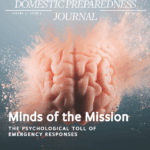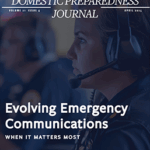
Archives

In an era of increasingly frequent and severe weather events, the demands on first responders have never been greater. To navigate high-stakes, rapidly evolving situations, reliable connectivity and cutting-edge technology are essential. A fast, secure, and resilient communications network is the backbone of any effective disaster response.

The Current State of the Opioid Crisis & Other Emerging Threats
January 22, 2025
Opioid deaths have surged dramatically since the pandemic. Manufacturers exploit legal loopholes and use precursor chemicals that often evade detection and regulation. These new and growing threats present challenges to public safety that demand innovative solutions and a proactive approach.

Introducing AI to the Emergency Management Workforce: A Case Study
December 18, 2024
AI can contribute to professional competency and learners’ success while efficiently training emergency management professionals and managing the bottom line.

Opportunities for Artificial Intelligence in Emergency Management
December 18, 2024
Recent research into the relationship between AI and emergency management uncovered an environment prepared for AI-based solutions. While AI must overcome some infrastructure hurdles, technologies to prevent, mitigate, and recover from emergencies are on the horizon.

Emergency Management of Tomorrow: Emerging Technologies and Concepts
December 11, 2024
More frequent and intense disasters put pressure on emergency managers and emergency operations centers to share and analyze data faster than ever before and with more reliability and defensibility. The future of emergency management is changing fast—and so is the science and technology to protect it.

Cyber and Physical Resilience in the Food and Agriculture Industry
October 16, 2024
Despite low profit margins and major setbacks caused by natural hazards and disasters, the food and agriculture sector continues to find innovative solutions. Balancing and integrating new concepts and technological advancements with an old-school farming mentality will keep this sector resilient and thriving when battling cyber and environmental threats.

Backyard Cybersecurity: The Local Challenge
October 16, 2024
The modern world increasingly relies on rapidly advancing digital technology, and cybercriminals progressively focus on ways to exploit technology’s vulnerabilities. Although higher levels of government and businesses may possess the tools necessary to protect against cyberattacks, local governments often do not.

Crisis Communications: Reaching Teens and Young Adults
September 18, 2024
Generation Z and millennials encompass almost half of the world’s population, and their communication style, preferences, and ideals differ from those of their older counterparts. Crisis communication plans must account for these differences to reach that demographic. Navigating these variations helps ensure that alerting organizations’ efforts are well-received and effective.

Fentanyl Hazards and Detection
June 12, 2024
The deadly opioid epidemic in the United States does not stop at overdoses. It also poses life-threatening exposure to first responders who arrive on scene. Learn about the new ways scientists at Pacific Northwest National Laboratory are expanding detection strategies and technologies to keep these responders safe.

Amateurs of Action – The Women of Radio
March 6, 2024
Volunteers are transforming emergency preparedness with an inclusive, diverse movement of impactful community engagement. Explore the inspiring stories of some remarkable women breaking barriers and building resilient communication networks in the heart of amateur radio.





